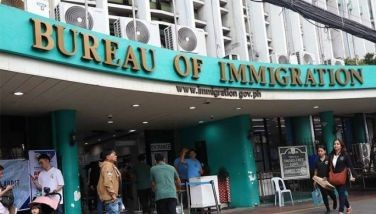Lapu-Lapu and Boni Sibayan

April 21, 2005 | 12:00am
On April 27, a 50-foot monument of Lapu-Lapu, one of the greatest heroes of the Philippines, will be inaugurated, an act that will possibly move him up from the consciousness of many young Filipinos as a mere fish to a national icon. The older generation, I’m sure, think of the Muslim chieftain as the one who felled the colonialist circumnavigator Ferdinand Magellan. It was ironic that Lapu-Lapu and his warriors, carrying only crude wooden arms, defeated Magellan’s invading battalion equipped with more modern weapons. For indeed, Lapu-Lapu was the first Asian to resist, and win over Western invasion; his victory was the first triumph of Asians over Western colonizers.
When Richard Gordon was tourism secretary in 2003, he was able to solicit a donation from the Korean Freedom League through its chairman, Kwon Jung-dal, to erect a Lapu-Lapu monument as its expression of gratitude for the thousands of Filipino veterans who fought, sacrificed and died during the Korean War for liberation. The Koreans agreed, finding in the request a fitting gift for the war veterans.
The statue now stands among busts and statues of Filipino martyrs at the Rizal Park. Made by a Filipino sculptor, Lapu-Lapu stands with his head held up with pride, and his sword is buried in sand, signifying that he comes in peace and welcomes people but reminds one that should anyone try to wage war, he would be ready to fight to protect his people. Dick proudly told the Bulong Pulungan sa Westin Philippine Plaza that the Lapu Lapu Monument is "a sentinel of freedom."
Dick Gordon, now a senator, has previously built monuments such as the "Ulo ng Apo" in Olongapo City in his efforts to unite a then divided community; the "Children of the Sun Returning" in Subic Bay to honor the volunteers, and the "Volunteers’ Shrine" where names of the more than 25,000 volunteers who built Subic are listed like those in the Vietnam War. The engaging legislator says, "Those who look back at the past puts pride in the future."
Another hero, in a different category, is the late Dr. Bonifacio P. Sibayan, who died January 28, 2005 after a courageous battle against stomach cancer. He was 88. He had been hoping to have the strength to attend his birthday celebration of February 5th (his birthday was February 1), hosted by the Linguistics Society of the Philippines as part of the annual lecture of the Bonifacio Sibayan Distinguished Professorial Chair in Applied Linguistics at De la Salle University.
Dr. Sibayan had been internationally acclaimed as one of the world’s pioneering scholars in sociolinguistics and one of the most well-respected linguists in the Philippines. He served as a member of the SIL Advisor Council since 1994 and had always been a strong supporter of SIL’s work in language research and linguistics.
Dr. Sibayan and his wife Isabel encouraged their children to achieve the highest standards in educational, professional and personal terms. All their children and grandchildren are college graduates. Dr. Sibayan sheepishly said, "There’s not a black sheep in the family!"
The couple experienced deep sadness when both their sons Noel and Reynato died in the same year — 2001. Mrs. Sibayan suffered failing health over the last few years, and Dr. Sibayan, always a devoted and faithful husband, took good care of her.
Brother Andrew Gonzalez, former Education Secretary, gave a touching homily to the late linguist during the SIL Advisory Council meeting last month. During his term as education secretary, Brother Andrew served as SIL Advisory Council chair. Also present at the meeting were former education secretaries who also served as SIL Advisory Council chairpersons Lourdes Quisumbing and Edilberto de Jesus. Presiding at the last meeting was the new secretary — Florencio Abad.
Mr. Abad recalled his first encounter with SIL. He was running for the House of Representatives, and he realized he only knew a smattering of his native Ivatan language, and this would not sit him well with the local voters. Like many well-educated Filipinos, he spoke and thought in English, and did not in his own language. His mother said he should learn to speak Ivatan, and recommended that he bone up through some literature prepared by SIL linguists. He did, and his instant proficiency in the language probably helped him get a seat in Congress. He had to give up his seat, however, when he was appointed education secretary.
Like all advisory council members, I am continuously impressed with the work of SIL Philippines. Work of SIL began in the Philippines in the ’50s, upon the invitation of the late President Ramon Magsaysay to begin development work with the indigenous cultural communities of the country.
Materials on the organization spell out the impact of SIL’s work. There are 120 spoken languages and dialects in the country, and SIL has contributed to language research in 105 Philippine languages. SIL linguists have authored more than 3,500 works related to Philippine research in anthropology, linguistics, literacy, and translation. Some chapters of the Old and New Testaments have been translated to Philippine languages.
SIL is a non-government organization, and receives funds through various individuals and funding agencies. Members are volunteers from 18 different countries, including the Philippines, who raise funds themselves to support their work.
SIL is the acronym of Summer Institute of Linguistics. Its history is traced back to 1934 when William Cameron Townsend began linguistics and anthropology courses for students interested in fieldwork overseas. The courses were held in the summer at a small community in Arkansas. In 1942 the summer program was moved to the University of Oklahoma, and remained there for many years. Because of this seasonal schedule, Townsend labeled the training the Summer Institute of Linguistics. Over time the full name of the organization was dropped and the initials SIL became the name of recognition in many places worldwide. SIL International has recently been adopted officially as a public name. SIL members serve in 70 countries around the world.
An estimated thee million people have become literate round the world through SIL programs. SIL has provided literacy, community development and education in 750 languages spoken by 70 million people worldwide. It introduced literacy in the vernacular for the first time.
SIL international is recognized as an NGO in special consultative status with the UNESCO. Individual members of SIL Philippines are recognized as experts in such fields as literacy, translation, and community development by institutions such as the Asia Development Bank. In 1973, SIL was awarded the Ramon Magsaysay Award for International Understanding.
My email:[email protected]
When Richard Gordon was tourism secretary in 2003, he was able to solicit a donation from the Korean Freedom League through its chairman, Kwon Jung-dal, to erect a Lapu-Lapu monument as its expression of gratitude for the thousands of Filipino veterans who fought, sacrificed and died during the Korean War for liberation. The Koreans agreed, finding in the request a fitting gift for the war veterans.
The statue now stands among busts and statues of Filipino martyrs at the Rizal Park. Made by a Filipino sculptor, Lapu-Lapu stands with his head held up with pride, and his sword is buried in sand, signifying that he comes in peace and welcomes people but reminds one that should anyone try to wage war, he would be ready to fight to protect his people. Dick proudly told the Bulong Pulungan sa Westin Philippine Plaza that the Lapu Lapu Monument is "a sentinel of freedom."
Dick Gordon, now a senator, has previously built monuments such as the "Ulo ng Apo" in Olongapo City in his efforts to unite a then divided community; the "Children of the Sun Returning" in Subic Bay to honor the volunteers, and the "Volunteers’ Shrine" where names of the more than 25,000 volunteers who built Subic are listed like those in the Vietnam War. The engaging legislator says, "Those who look back at the past puts pride in the future."
Dr. Sibayan had been internationally acclaimed as one of the world’s pioneering scholars in sociolinguistics and one of the most well-respected linguists in the Philippines. He served as a member of the SIL Advisor Council since 1994 and had always been a strong supporter of SIL’s work in language research and linguistics.
Dr. Sibayan and his wife Isabel encouraged their children to achieve the highest standards in educational, professional and personal terms. All their children and grandchildren are college graduates. Dr. Sibayan sheepishly said, "There’s not a black sheep in the family!"
The couple experienced deep sadness when both their sons Noel and Reynato died in the same year — 2001. Mrs. Sibayan suffered failing health over the last few years, and Dr. Sibayan, always a devoted and faithful husband, took good care of her.
Mr. Abad recalled his first encounter with SIL. He was running for the House of Representatives, and he realized he only knew a smattering of his native Ivatan language, and this would not sit him well with the local voters. Like many well-educated Filipinos, he spoke and thought in English, and did not in his own language. His mother said he should learn to speak Ivatan, and recommended that he bone up through some literature prepared by SIL linguists. He did, and his instant proficiency in the language probably helped him get a seat in Congress. He had to give up his seat, however, when he was appointed education secretary.
Materials on the organization spell out the impact of SIL’s work. There are 120 spoken languages and dialects in the country, and SIL has contributed to language research in 105 Philippine languages. SIL linguists have authored more than 3,500 works related to Philippine research in anthropology, linguistics, literacy, and translation. Some chapters of the Old and New Testaments have been translated to Philippine languages.
SIL is a non-government organization, and receives funds through various individuals and funding agencies. Members are volunteers from 18 different countries, including the Philippines, who raise funds themselves to support their work.
SIL is the acronym of Summer Institute of Linguistics. Its history is traced back to 1934 when William Cameron Townsend began linguistics and anthropology courses for students interested in fieldwork overseas. The courses were held in the summer at a small community in Arkansas. In 1942 the summer program was moved to the University of Oklahoma, and remained there for many years. Because of this seasonal schedule, Townsend labeled the training the Summer Institute of Linguistics. Over time the full name of the organization was dropped and the initials SIL became the name of recognition in many places worldwide. SIL International has recently been adopted officially as a public name. SIL members serve in 70 countries around the world.
An estimated thee million people have become literate round the world through SIL programs. SIL has provided literacy, community development and education in 750 languages spoken by 70 million people worldwide. It introduced literacy in the vernacular for the first time.
SIL international is recognized as an NGO in special consultative status with the UNESCO. Individual members of SIL Philippines are recognized as experts in such fields as literacy, translation, and community development by institutions such as the Asia Development Bank. In 1973, SIL was awarded the Ramon Magsaysay Award for International Understanding.
My email:[email protected]
BrandSpace Articles
<
>
- Latest
- Trending
Trending
Latest
Trending

By BABE’S EYE VIEW FROM WASHINGTON D.C. | By Ambassador B. Romualdez | 15 hours ago

By IMMIGRATION CORNER | By Michael J. Gurfinkel | 15 hours ago
Latest
Recommended


























